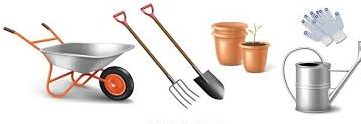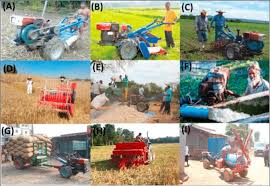The contribution of horticultural and floricultural crops to total agricultural production in the country is significant due to the highly favorable and varied agro-ecological diversities.
Major field operations for horticultural crops include nursery/seedling preparation, post-hole digging for planting, earthing, irrigation, plant protection, harvesting, handling, packaging, and transport.
The cultivation of horticultural crops is predominantly dependent upon human labor, as commercial cultivation is only on a limited scale. Animal/power tiller or tractor-drawn moldboard ploughs, disc ploughs, harrows, cultivators, and rotavators are available and used for land preparation.
Read Also: 16 Medicinal Health Benefits Of Scleromitrion diffusum (Spreading Diamond Flower)
Horticultural Tools and Their Uses

Some important tools used in horticultural farms include the following:
1. Pick Axe: The pick axe has a long wooden handle with a double-headed thick metal blade attached through a loop. The head consists of two edges: one end is pointed, while the other is flat and sharp-edged. It is mainly used for breaking up hard soil and digging up roots and tree stumps.
2. Axe: An axe is a simple hand tool, consisting of a cutting edge and an eye for fixing the handle. It is a multipurpose cutting tool used for felling and delimbing trees, splitting logs for firewood, and dressing logs for timber conversion. Small axes are also used for clearing bushes.
3. Cutlass: The cutlass is one of the most commonly used farm tools in Nigeria. It comes in various shapes and sizes, with a flat long metal blade and a short wooden or plastic handle.
One edge is sharp, while the other is blunt. It performs many functions, including clearing bushes, felling large trees, and harvesting crops like sugar cane, maize, cassava, yam, and palm nut fruits.
The cutlass is also used for planting melons, transplanting seedlings, weeding crops, digging shallow holes, and pruning flowers.
4. Hand Fork: Resembling a kitchen fork but larger, the hand fork has a short wooden or metal handle with four prongs. It is used for mixing manure into the soil, breaking the surface for better air and water penetration, and removing weeds from the seedbed.
5. Hand Trowel: A boat-shaped or curved metal blade attached to a short wooden or metal handle defines the hand trowel. It is used for transplanting seedlings, applying fertilizers and manure, loosening vegetable beds, light weeding, mixing soil, and digging holes for planting seeds.
6. Sickle: A sickle has a curved metal blade fitted into a short wooden handle. The inner part of the blade is sharp, while the other side is blunt. It is used for plucking fruits when tied to a long handle, harvesting cereals like rice, wheat, and barley, and cutting grasses.
7. Hammer: The hammer consists of a thick, heavy metal head attached to a straight wooden or metal handle. It has a prong for removing nails and is used for driving nails into wooden structures, straightening bent components of farm implements or home furniture, and removing nails from wood.
8. Mallet: The mallet has a large wooden head with a wooden handle, used for hitting pegs into the ground without damaging them.
9. Hoe: The hoe comes in different types, including the West African and Indian hoe. The West African hoe has a short curved handle, while the Indian hoe has a long handle. Hoes are used for tilling soil, harvesting crops like cassava, sweet potato, and cocoyam, weeding between rows of crops, digging drains, making trenches, and forming ridges and mounds.
10. Spade: The spade consists of a long rectangular flat blade attached to a long cylindrical handle, widening at the end to form a D-shaped hole. It is used for digging holes, leveling the ground, making seedbeds, ridges, and mounds, transplanting seedlings, turning the soil, mixing manures, and light weeding in both farms and homes.
11. Watering Can: Made of galvanized iron or synthetic rubber, the watering can features a tank, handle, and spout. The spout has a perforated metal sheet (known as the ROSE) to distribute water. It is used for applying water to crops like seedlings in a nursery and vegetables, as well as liquid fertilizers and watering cement blocks for construction.
12. Garden Fork: The garden fork is used for turning manure during compost making and spreading manure in open fields. It also loosens the soil before transplanting.
13. Digging Mattock: The digging mattock is used for digging and uprooting small stumps.
14. Rake: The rake is used for leveling the soil surface, breaking large soil crumbs, removing stones and weeds from seedbeds, and covering vegetable seeds when broadcasted.
15. Garden Line: A garden line is used for lining up beds and making straight lines during planting.
16. Wheelbarrow: The wheelbarrow is used for conveying materials like tools, seedlings, and manure to and from the farm.
17. Tape: The tape is used for taking short or detailed measurements on the field.
18. Ranging Pole: A ranging pole is used for marking surveyed stations or intermediate stations, and for marking straight lines.
19. Budding and Grafting Knife: A budding knife consists of a folding blade with two edges: one sharp along its length, and the other slightly curved and sharpened at the tip. It is used for budding and grafting in vegetable nurseries and fruit gardens, as well as cutting unwanted twigs and defoliating leaves.
20. Secateurs: Secateurs have two metal blades one concave, the other convex joined together at a point with short metal handles and a spring in between. They resemble a pair of scissors and are used for trimming flowers, pruning branches of shrubs and trees, and pruning vines.
21. Chain Saw: Also called a power saw, the chain saw is a portable machine with an endless chain running around a flat bar. It is used for trimming dead or diseased wood, removing inconveniently placed branches, or felling trees.
22. Shears: Shears are a large pair of scissors with long blades connected by a bolt and nut. They are handled with both hands and are used for pruning trees, trimming hedges, cutting shrubs, and removing haphazard growth in gardens and lawns.
23. Lopping Shears: Lopping shears are used for pruning and cutting branches and twigs of orchard trees that are out of reach of standard pruning tools.
24. Grass Shears: Grass shears are used for trimming lawns, side-dressing grass, and cutting soft vegetative material. They may also be used for shearing sheep wool.
25. Crowbar: Made from structural or medium carbon steel, the crowbar is used for digging holes or pits for planting and fencing.
Read Also: 12 Medicinal Health Benefits Of Renealmia alpinia (Pink cone ginger)
Horticultural Machinery and Implements

Machines in horticulture help direct forces and energy to improve agricultural work. Common horticultural machines include:
1. Tractor: A tractor is an essential agricultural machine designed to move easily across the ground and provide pulling power for various agricultural tasks, even in flooded fields. Tractors come in two types: tracked (providing stability and strength) and wheeled (able to travel by road at higher speeds).
2. Walking Tractor: A walking tractor is a single-axle machine operated by handles. It has moderate motor power and is best for horticultural and ornamental work, particularly in garden construction.
3. Sprayer: A sprayer consists of a liquid tank, pressure pump, nozzle, and hose, used for applying insecticides, fungicides, or herbicides. Hand sprayers are often worn on the back to minimize exposure to harmful chemicals.
4. Knapsack Sprayer: A knapsack sprayer is a portable sprayer used for applying chemicals to crops in the field.
5. Mower: A mower is used for cutting grass and maintaining lawns and fields.
6. Plough: Ploughs are used to open furrows in the soil and include various types such as the moldboard plough, disc plough, and subsoil plough. These tools help in soil preparation, removing topsoil, and creating proper planting conditions.
For efficient farm operation, farmers use both tools and machinery to ease tasks, increase speed, and cover larger areas in less time. While commercial farmers often rely on advanced machinery, subsistence farmers typically use local tools for their operations.
Do you have any questions, suggestions, or contributions? If so, please feel free to use the comment box below to share your thoughts. We also encourage you to kindly share this information with others who might benefit from it. Since we can’t reach everyone at once, we truly appreciate your help in spreading the word. Thank you so much for your support and for sharing!

